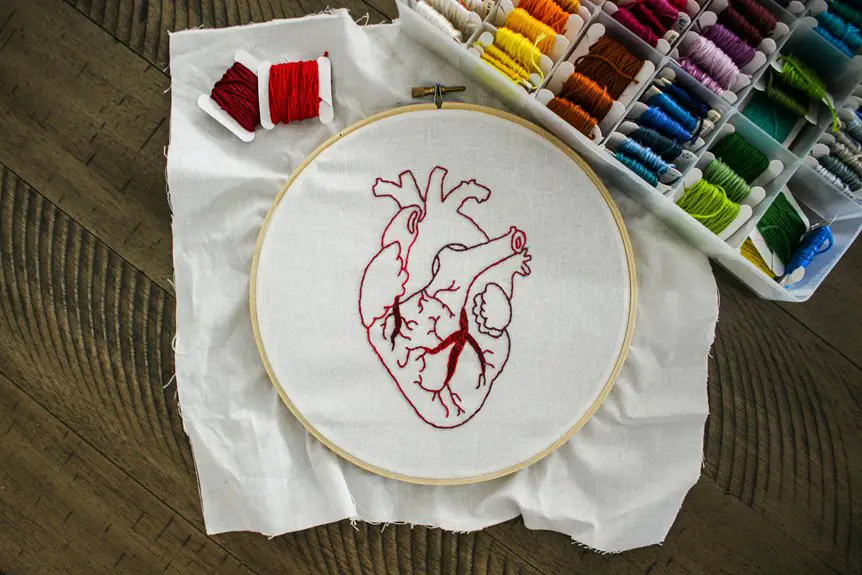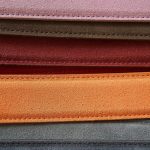When sewing with cotton lawn fabric, use a sharp, fine needle and lightweight thread to avoid snagging and puckering. Pre-wash the fabric gently to prevent shrinkage, and cut with care using fine pins or clips to keep layers secure. Take your time stitching with a steady, moderate speed, and finish seams with gentle techniques like French seams to prevent fraying. If you want to create beautifully tailored projects, mastering these basics will set you up for success.
Table of Contents
Key Takeaways
- Use a sharp, fine needle (size 60/8 or 70/10) to avoid snagging the delicate cotton lawn fabric.
- Pre-wash the fabric gently in cold water to prevent shrinkage and maintain softness before cutting.
- Employ fine pins or clips and a rotary cutter for precise, clean edges without damaging the fabric.
- Sew with lightweight 50-weight cotton or polyester thread to match fabric breathability and avoid puckering.
- Finish seams with French seams or bias binding to prevent fraying and maintain garment durability.
Understanding the Properties of Cotton Lawn Fabric
Cotton lawn fabric feels lightweight and smooth, making it perfect for delicate sewing projects. When you work with it, you’ll notice its fine weave and crisp texture, which gives your finished pieces a polished look.
It’s breathable and soft, so garments made from cotton lawn feel comfortable against your skin. Despite its thinness, it holds shape well, but you’ll want to handle it gently to avoid puckering or stretching.
Since it’s semi-sheer, you might need to contemplate lining or layering depending on your project’s opacity needs. Also, it presses beautifully, so you can achieve sharp seams and edges easily.
Understanding these features helps you plan your sewing approach and select suitable patterns.
Essential Tools and Supplies for Sewing Cotton Lawn
To sew cotton lawn fabric successfully, you’ll need the right tools and supplies at hand.
Choosing the best thread and having proper fabric preparation items can make a big difference in your project.
Let’s explore the must-have sewing tools and essentials to get you started.
Must-Have Sewing Tools
Although sewing with delicate fabrics can be challenging, having the right tools makes all the difference when working with cotton lawn.
You’ll want a sharp, fine needle—size 70/10 or 60/8—to prevent snagging. Use fine pins or clips to hold pieces without leaving marks. A rotary cutter and cutting mat help you achieve clean, precise edges. Lightweight scissors dedicated to fabric will keep your cuts smooth.
A pressing cloth is essential to protect the fabric when ironing. Don’t forget a seam ripper for quick fixes without damaging fibers. Finally, a good quality sewing machine with adjustable tension settings guarantees even stitches.
With these tools, you’ll handle cotton lawn confidently and create beautiful, delicate garments with ease.
Best Thread Choices
Choosing the right thread can make or break your sewing project with cotton lawn fabric. Since cotton lawn is lightweight and delicate, you want a thread that’s strong yet fine to avoid puckering or damaging the fabric.
Opt for high-quality cotton or polyester threads in a lightweight 50-weight or finer. Cotton thread matches the fabric’s breathability and weight, while polyester offers extra strength and slight stretch, which can be helpful for seams under stress.
Avoid heavy or coarse threads—they’ll weigh down your fabric and leave visible stitching. Also, choose a thread color that blends well with your fabric to keep seams discreet.
Using the best thread guarantees smooth stitching, durability, and a polished finish on your cotton lawn garments.
Fabric Preparation Supplies
When working with cotton lawn, having the right fabric preparation supplies guarantees smooth cutting and sewing.
You’ll want to gather tools that help maintain the delicate texture and prevent shifting. Here are three essentials:
- Sharp Fabric Scissors or Rotary Cutter – These give you clean, precise cuts without fraying the fine threads.
- Fine Pins or Fabric Clips – Use these to hold layers together gently without leaving marks or snagging.
- Spray Starch or Fabric Stabilizer – Lightly applying this improves handling and reduces stretching or puckering during sewing.
Preparing Cotton Lawn Fabric for Sewing
Before you start sewing, make sure to pre-wash your cotton lawn fabric to prevent shrinkage later.
Handle it gently to avoid stretching or distorting the delicate fibers.
Once dry, iron the fabric carefully to create a smooth, easy-to-sew surface.
Pre-Washing Techniques
Two simple steps will help you prepare your cotton lawn fabric for sewing: washing and drying it properly. Pre-washing guarantees the fabric won’t shrink or bleed colors after your project is complete. Follow these steps:
- Hand wash or machine wash on gentle cycle with cold water to protect the delicate fibers.
- Use mild detergent to avoid damaging the fabric’s softness and color.
- Avoid fabric softeners or bleach, as they can weaken the fabric or alter its appearance.
After washing, gently squeeze out excess water without wringing.
Then, air dry your fabric flat or hang it to dry in a shaded area to prevent fading.
Taking these simple precautions will make your cotton lawn fabric ready for smooth, successful sewing.
Handling and Ironing Tips
Mastering three key handling and ironing techniques will guarantee your cotton lawn fabric stays smooth and easy to work with.
First, always handle the fabric gently to prevent distortion since it’s lightweight and delicate. Use sharp scissors or a rotary cutter for clean edges.
Second, press the fabric with a warm iron set to cotton or a low synthetic setting. Avoid high heat to prevent scorching.
Third, iron on the wrong side of the fabric using a pressing cloth to protect the surface and maintain its crisp finish. Use steam sparingly to avoid stretching the fabric.
Following these steps assures your cotton lawn remains crisp, flat, and ready for precise sewing, helping you achieve professional-looking results every time.
Cutting Techniques for Delicate Cotton Lawn
Although cotton lawn feels delicate, you can cut it cleanly by using sharp tools and steady hands. Here’s how to master cutting this fine fabric:
- Use a rotary cutter or sharp fabric scissors to avoid snagging the fibers. Dull blades will cause fraying and uneven edges.
- Cut on a flat, stable surface with plenty of light. This helps you see the fabric grain and cut accurately.
- Pin your pattern pieces carefully but don’t over-pin. Too many pins can distort the fabric; place them just enough to keep layers aligned.
Stitching Tips to Prevent Fabric Damage
Once you’ve cut your cotton lawn fabric with care, sewing it without causing damage is the next step to guarantee a polished finish.
Use a fine needle, like a size 70/10 or 60/8, to avoid snagging the delicate fibers. Opt for a short stitch length, around 2.0 mm, to strengthen seams without puckering.
Avoid pulling the fabric; instead, gently guide it through your machine to prevent stretching or distortion. Use lightweight thread, such as cotton or polyester, which complements the fabric’s softness.
Press seams lightly with a cool iron and use a pressing cloth to protect the fabric’s surface. By following these stitching tips, you’ll maintain the integrity of your cotton lawn and create smooth, professional-looking seams every time.
Finishing and Caring for Cotton Lawn Garments
To keep your cotton lawn garments looking fresh and vibrant, you need to finish and care for them properly.
Start by securing all seams with a neat finish like French seams or bias binding to prevent fraying. Next, wash your garment gently in cold water with a mild detergent to preserve the fabric’s softness and color.
Finally, air-dry your garment flat or hang it to dry, avoiding direct sunlight which can fade the fabric.
Here’s a quick care checklist for your cotton lawn pieces:
- Use gentle seam finishes to protect edges.
- Wash in cold water with gentle detergent.
- Air-dry away from direct sunlight to maintain color.
Following these steps will keep your cotton lawn garments looking great for a long time.
Frequently Asked Questions
Can Cotton Lawn Fabric Be Used for Quilting Projects?
You can use cotton lawn for quilting, you can appreciate its softness, and you can enjoy its lightweight feel. Just remember to handle it gently, pre-wash it, and pair it with a suitable batting for best results.
How Does Cotton Lawn Compare to Cotton Voile?
You’ll find cotton lawn is slightly crisper and more tightly woven than cotton voile, which feels softer and sheerer. Both are lightweight, but lawn offers more structure, while voile drapes delicately for flowy garments.
Is Cotton Lawn Suitable for Baby Clothing?
Looking for soft, breathable fabric for baby clothes? Cotton lawn fits perfectly—it’s lightweight, smooth, and gentle on sensitive skin. You’ll love how comfortable and durable it feels, making it ideal for your little one’s wardrobe.
Can I Dye Cotton Lawn Fabric at Home?
You can definitely dye cotton lawn fabric at home. It absorbs dye well, giving vibrant colors. Just use fiber-reactive dyes, follow instructions carefully, and pre-wash the fabric to guarantee even, lasting results on your project.
What Are Common Patterns for Cotton Lawn Garments?
Think of cotton lawn as a gentle breeze—perfect for airy blouses, delicate dresses, and lightweight skirts. You’ll often find floral prints, crisp shirts, and summer tunics made from this soft, breathable fabric that breathes life into your wardrobe.
- Tetron Fabric for Marine Applications: Durability and Use Cases - June 18, 2025
- Tetron Fabric for Outdoor Furniture: Weather Resistance and Care - June 18, 2025
- Tetron Fabric for Wall Coverings: Style and Application Tips - June 18, 2025







